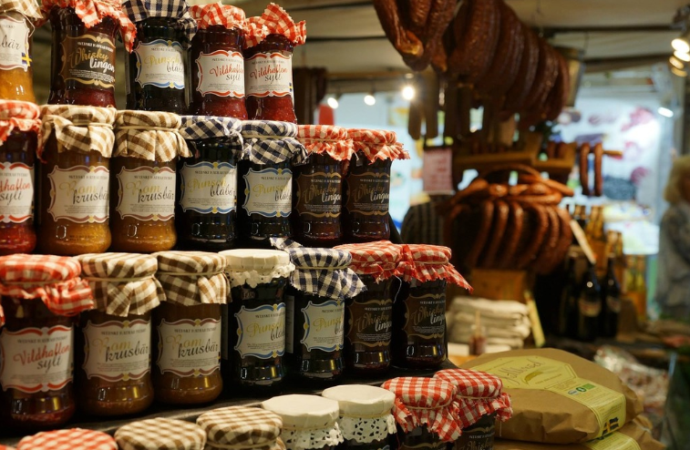There’s a famous experiment involving jams. Not problems, and not what old people call music, but the third thing: sweetened and thickened fruit spreads.
The experiment famously showed that at some point having additional choices is overwhelming, and actually appears to make people worse off. There were actually three studies, though for some reason the “jam experiment” is the most famous.
Study 1: Jam Selection Experiment
The experiment was conducted in a gourmet food store with tasting booths offering either 6 or 24 varieties of jam. Approximately 60 percent of shoppers stopped to peruse the extensive-choice display, while 40 percent approached the limited-choice display. Surprisingly, however, 30 percent of those who sampled from the limited selection made a purchase (a code on the back of the coupon told researchers which display each eventual buyer had seen), compared to only three percent from the more extensive selection. More choices generated more interest, but significantly less action.
Study 2: Essay Topic Selection Experiment
College students were offered (PDF) either six or 30 topics for an optional essay assignment. Students given six topics were more likely to complete the assignment and produced higher-quality essays than did those given 30 topics. Choice can be demotivating.
Study 3: Chocolate Selection Experiment
Participants were asked to choose a chocolate from either a selection of six or 30 options. Those with six options reported greater satisfaction with their choice and were more likely to select chocolate over monetary compensation than those with 30 options.
Together, these three studies suggest a model of how we decide. While a larger array of choices may initially attract interest, too many choices can ultimately reduce motivation to make a decision and decrease satisfaction with the chosen option.
This has been widely interpreted to be a criticism of capitalism, but it isn’t. In a commercial society, there are two factors that the experiments ignore.
Brand names: People may shop around at first, but they also use brand names and reviews to settle on a choice. In an actual grocery store, with brand names of recognizable products, people don’t spend hours in the cereal aisle. They go, look for a second at their favorite cereals, and then make a choice. Easy peasy. But then why are there so many choices? That leads to point two.
Profit as a selection device: For a cereal to survive, and compete for shelf space, some minimum number of people must buy the cereal, enabling the producer to cover all costs and make a return equal to or greater than their opportunity cost of capital.
Taken together, these two things mean all those cereals have a significant number of people who are looking for that cereal, and no other, and who buy that cereal. Further, the number of buyers must be sufficient to cover the social “investment” in that brand and flavor. So while the cereal aisle, or jam rack, may appear wasteful or excessive to an academic with little idea how commerce works (perhaps because they’ve never had a real job), it is in fact a carefully curated and efficient mechanism for providing choices people actually want. (Further, the experiment itself has some pretty serious problems…)
BUT: Social Media?
The argument above, while correct (IMHO), requires quite a bit of machinery to operate in the background. The commercial system, once mature, maintains a profit-and-loss test, and nurtures the use of brand name and reputation to simplify and curate choice. What looks like chaos is in fact well-ordered: jars of jam are expensive to manufacture and ship, and the shelf space has an opportunity cost, so that only jam people want is provided (at least over time).
None of those conditions exist, at least not yet, in the wild world of social media. The costs of manufacture and distribution are negligible, and the opportunity cost of “shelf space” on the internet is just the competition for attention, because platforms are nearly free.
Kevin Munger (yes, my son) recently wrote a piece exploring this problem. His article “Unbundling and Abundance” addresses the impact of technological advancements on the production and consumption of cultural products. Kevin argues that these are the main issues:
- Technological Advancements: The rise of the internet and digital tools has lowered barriers to entry for creators, leading to an explosion of content across various media forms.
- Unbundling: Traditional media packages, such as albums or cable TV bundles, are being broken down. Consumers now have the freedom to select individual pieces of content, tailoring their media consumption to personal preferences.
- Abundance of Content: This unbundling has resulted in an overwhelming abundance of content, making it challenging for consumers to discover high-quality material amidst the vast options available.
- Absence of Gatekeeping: The role of traditional gatekeepers, like editors and producers, has diminished. In their place, algorithms and social media trends have become the new curators — determining what is important — and verifiers — determining what is true. The consequence is that the most prominent content is disconnected from profit-and-loss calculus, as well as quality ‘buyer’ feedback.
These trends in media production and consumption have significant economic implications. While more creators can share their work, monetizing content has become complicated. On one hand, anyone can now publish content and charge whatever audiences will pay through services like substack and Patreon. On the other hand, the enormous flood of new content raises the level of competition to earn a sustainable income.
The shift towards unbundled content consumption can lead to fragmented cultural experiences, as shared media experiences become less common. In particular, as legacy print and television outlets have lost their stranglehold over reader attention and ad dollars have moved to more precisely targeted platforms on social media, the traditional mainstream media have lost their authority.
I have often been quite critical of people who naively claim markets create “excessive choice,” because brand names, selection by profit and loss, and differences in taste are factors that such critiques usually miss. But social media may, in fact, be an example where the “jam problem” is real. We have so many choices that it’s impossible to select for quality or feel satisfaction with one’s choice.
Eventually, as Kevin points out, there may emerge new models of curation, verification, and monetization to navigate this landscape, but for now abundance and unbundling are getting worse, not better.
—
This article first appeared at The Daily Economy, an imprint of the American Institute for Economic Research, on March 26, 2025. CC-BY-4.0
Image Credit: Pixabay
6 comments















6 Comments
alvinlees
April 8, 2025, 3:47 amMy marriage was restored and my husband came back to me he apologized for all the wrongs he did and promise never to do it again. A big thanks to this wonderful psychic for bringing my husband back to me.. I never really believed in magic spells or anything spiritual but a trusted friend opened my eyes to the truth about life. My marriage was heading to divorce a few months ago. I was so confused and devastated with no clue or help on how to prevent it, till I was introduced to Dr. Excellent that did a love spell and broke every spiritual distraction from my marriage. A day later my husband started showing me love and care even better than it used to be, he’s ready to talk things through and find ways for us to stay happy. It’s such a miracle that my marriage can be saved so quickly without stress. You can also contact him for help. Here his contact. Call/WhatsApp him at: +2348084273514 "Or email him at: [email protected]
REPLYEmma Clark
April 8, 2025, 10:26 amThe title resonates social media oftentimes feels confusing and disconnected. Having options can result in feeling more immobilized than energized. Getting clarity in these scenarios is an art, just like producing structured responses for CIPD Level 3 Assignment Writing Services https://cipdassignmenthelp.org.uk/.
REPLYCarrie Alfred
June 22, 2025, 9:13 amMy husband left me for another woman a few months ago and ever since then my life has been filled with pain and agony because my husband was my first love whom I have spent my entire life with. A friend and also a colleague from work told me he saw some testimonies of a spiritualist called Doctor Muna, he can bring back lover within some few days, Ridiculously, I laughed it out and said I am not interested but for the sake of friendship, she consulted this God sent man on my behalf and to my greatest surprise after 12 hours my husband called me for the very first time for over 7 months saying "I miss you babe and I'm so sorry for everything I made me went through" I couldn't say a word but cried over the phone and hanged up. We are back together and living Happily together again. To be honest, I still can’t believe it, because it’s highly unbelievable. Thank you DOCTOR MUNA for bringing back my love and also to my SELFLESS FRIEND. Laura, who interceded on my behalf. For anyone who might need help of this wonderful spiritualist here is the email address: [email protected], Also add him on WhatsApp: +2347035449257
REPLYCrown Pokies Online
July 18, 2025, 9:02 amPlanning a chill evening with snacks, I thought some online gaming would add a spark. Searched for a site with cool visuals and secure payments. Crown Pokies, an Aussie platform, has tons of 3D slots and table games. It’s got strong security measures and weekly bonuses. Personally, it turned my night into a fun adventure with its sleek interface.
REPLYglory casino
July 31, 2025, 3:49 amHello! I want to share my positive experience with glory casino. The site offers a wide variety of games, from slots to table games, so there’s something for every player. The bonuses and promotions are fair and rewarding, which keeps me coming back. I also love how secure the platform feels—my personal data is well protected. Overall, glory casino has exceeded my expectations, and I’m happy to recommend it to others!
REPLY